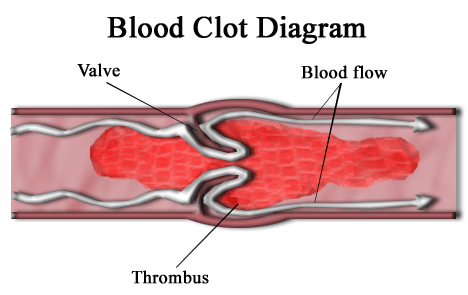
Recently Diagnosed or Relapsed? Stop Looking For a Miracle Cure, and Use Evidence-Based Therapies To Enhance Your Treatment and Prolong Your Remission
Multiple Myeloma an incurable disease, but I have spent the last 25 years in remission using a blend of conventional oncology and evidence-based nutrition, supplementation, and lifestyle therapies from peer-reviewed studies that your oncologist probably hasn't told you about.
Click the orange button to the right to learn more about what you can start doing today.
- You are here:
- Home »
- Blog »
- Multiple Myeloma »
- Myeloma Side Effect, COD- Blood Clot
Myeloma Side Effect, COD- Blood Clot

“…over 9,000 multiple myeloma patients, we found, in contrast to previously published studies, that the occurrence of any thrombosis was associated with a significantly poorer survival.”
Deep vein thrombosis is an important side effect to be wary of. Blood clots can be caused by multiple myeloma itself and can be caused by chemotherapy to treat MM.
Blood clots (thrombotic event) is one of the top five causes of death for MM survivors.
I developed my first blood clot shortly after I began my first course of induction therapy (1995) and I developed my second clot in the other leg a few years later.
The second clot never fully resolved. I have what is known as “Post Thrombotic Syndrome.” There is still some of the original blood clot clogging my leg a bit. If I stand for too long my calf swells.
My point is that hyper-viscosity is a sneaky sort of symptom, side effect of MM. A blood clot may seem harmless but make no mistake, blood clots can and do kill MM survivors.
The blog post “What is Multiple Myeloma? Oncology has it backwards…“ represents an “AHA” moment for me. When I read a study documenting that MM symptoms, side effects and causes of death all overlapped, I almost fell off my chair.
My blood clots occurred because of conventional therapies. Oncology has it backwards…I believe that ”the cure is worse than the disease,” as the saying goes…
I think a contributing factor, a problem that contributes to conventional oncology not understanding the long-term damage done by toxic therapies is the fact that different drug companies track side effects differently.
Multiple Myeloma Symptoms Cloud Multiple Myeloma Side Effects-
If you develop any of the signs below, please consider either/or conventional therapies or evidence-based non-conventional therapies shown to prevent or treat deep vein a thrombosis.
Signs of hyper-viscosity and deep vein thromboses are:
- shortness of breath,
- hypoxemia,
- acute respiratory failure, and
- hypotension
can result from this sludging of blood and decreased microvascular circulation.
Conventional therapies shown to increase the risk of blood clots:
- Multiple Myeloma Side Effects- Revlimid Risks Blood Clot Despite Blood Thinners
- MGUS- Slurring, Vision, Thick Blood?
Therapies shown to decrease the risk of blood clots:
- Multiple Myeloma Therapy- Curcumin for Both Symptoms, Side Effects
- Multiple Myeloma Side Effect- Resolve Blood Clots (VTE)
- Multiple Myeloma Chemotherapy- Probiotic, Diet, Supplement, Pre-habilitation
- Omega-3 Fatty Acids- A Long-Term Multiple Myeloma Survivor’s Best Friend-
- Low Vitamin D Levels in Stroke Patients Up Risk of DVT
Research and experience since my MM diagnosis in early 1994 has taught me that both conventional toxic therapies must be balanced with evidence-based but non-conventional therapies in order to balance the risk/reward, pros and cons that arise from our attempts to manage our multiple myeloma.
Learn More About Blood Clots aka Deep Vein Thromboses- click now
Scroll down the page to ask a question, make a comment. Thanks.
David Emerson
- MM Survivor
- MM Cancer Coach
- Director The Galen Foundation
Recommended Reading:
- Multiple Myeloma Side Effect- Blood Clot Therapies
- Multiple Myeloma Side Effects- Chemo & Blood Clot (VTE) Prevention
- Multiple Myeloma Side Effects- Resolving Blood Clots
Chemotherapy-induced thrombosis
“Venous thromboembolism (VTE) is a frequent and potentially life-threatening complication associated with hematological and solid tumor malignancies. In patients with cancer, VTE portends a poor prognosis; in fact, only 12% of those who suffer an event will survive beyond one year.
There are several different risk factors for the development of VTE in cancer patients that are well-described in the literature. One that has become increasingly recognized over the past two decades is the independent risk factor of chemotherapy.
The annual incidence of VTE in patients receiving chemotherapy is estimated at 11%. This risk can climb to 20% or higher depending on the type of drug(s) being administered.
In addition to chemotherapy, there are many other anti-neoplastic and supportive therapies that are also associated with an increased risk for the development of VTE..”
Thrombosis is associated with inferior survival in multiple myeloma
“In summary, in this large population-based study based on over 9,000 multiple myeloma patients, we found, in contrast to previously published studies, that the occurrence of any thrombosis was associated with a significantly poorer survival.
Multiple myeloma patients with an early arterial or venous thrombosis had a higher risk of death than patients without.
However, multiple myeloma patients with an early VTE who survived their first six months had similar survival rates to those without VTE. Therefore, our findings confirm that thrombosis in multiple myeloma patients is a serious complication, and that it increases mortality, also in the era of novel agents.”
How to Reduce Your Risk of Blood Clots (DVT and PE)
“Cancer patients have an elevated risk of developing life-threatening blood clots. For some patients, the type of cancer (multiple myeloma) they have can trigger blood clots. Some cancers actually produce substances which can activate the clotting cascade and produce blood clots (thrombosis).
…Additionally, some cancer drug therapies (i.e. Tamoxifen, progestins, aromatase inhibitors, thalidomide, cisplatin, antiangiogenic agents, etc.) and radiation therapy can cause inflammation and injure vascular endothelial walls, a set up for thrombosis.
- Eat foods rich in omega-3 fatty acids, which also help to thin blood (e.g., oily fish, flaxseed, sunflower seeds, green leafy vegetables). One study of nearly 22,000 individuals reported that those who consumed >4.7 grams per week of marine omega-3 fatty acids (from either fish or supplements) had a 22-26% lower risk of developing a DVT and 39-60% lower risk of developing a PE.
- Avoid excessive intake of saturated fats, sugar and salt
- Consider foods and supplements that reduce blood clotting: curcumin, polyphenol-rich foods (brightly colored fruits, vegetables and berries, olive oil) and drinks (green and black tea), foods rich in vitamin C (citrus, peppers, cruciferous vegetables, watercress, strawberries, spinach), garlic, onions, tomatoes, Gingko biloba, rutin (plant flavonoid), Danshen Compound Tablet (a traditional Chinese medicine formula: Salvia miltiorrhiza, Panax notoginseng and Borneum syntheticum), nattokinase (fermented soybean product)
Curcumin, hemostasis, thrombosis, and coagulation.
Platelet activation and aggregation play a central role in hemostasis and thrombosis. Herbal medicines have been traditionally used in the management of cardiovascular disease and can help in modifying its progression, particularly in hemostasis and the coagulation process, as well as altering platelet function tests and some coagulation parameters.
Modern scientific research has demonstrated its anti-inflammatory, antioxidant, anti-carcinogenic, antithrombotic, and cardiovascular protective effects.
The present study reviewed previous studies in the literature, which support the positive activity of curcumin in hemostasis, anticoagulation, and fibrinolysis…”
Protective effect of resveratrol, a red wine constituent polyphenol, on rats subjected to portal vein thrombosis.
“This experimental study investigated the prophylactic effects of the antioxidant and antiaggregant compound resveratrol (R) on portal vein thrombosis (PVT) in rats…”


